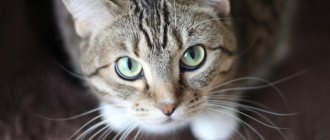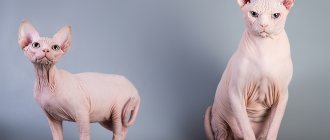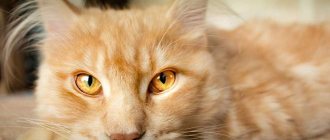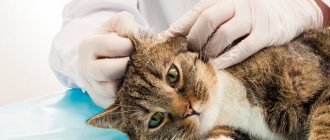How to examine a cat if its eyes are watery?
- As tragic as it may be, often the appearance of tears in a cat’s eyes indicates the presence of some kind of disease.
- Therefore, you need to pay attention to whether tears appeared for a short time and then disappeared, or whether the discharge in your cat’s eyes is present throughout the entire day, or worse, several days.
Tears
- If the cat’s tears are insignificant, and, having appeared in the morning, soon went away, there is nothing to worry about, and there is no reason for alarm.
- If your eyes “cry” for a long time, you should look for the cause of this phenomenon.
- When examining a cat with watery eyes, start by cleaning your hands to avoid further infection. Then try pulling down the upper eyelids on each eye .
- If the eyes are not cloudy, they shine, and the pupils are the same size, and the back surface of both eyelids is pale pink, and the cornea is transparent - everything is normal with the animal’s eyes.
Examine the animal
- If the eyelids are red or swollen, or the cornea is cloudy, this means that the cat has problems with the eyes.
- If the animal has difficulty opening its eyes or the inner surface of the eyelid is pulled up by a thin light film, it is better to visit a veterinarian as soon as possible.
Cat's eyes are watery: causes and treatment
Reasons why a cat's eyes water:
- with a foreign body in the eyes . It could be some kind of speck, fluff, twig, midge, and possibly dirt. If you find something like this, the first thing you should do is rinse the animal’s eyes under running water. Once the foreign object has been washed, apply 1% tetracycline ointment to the cat's upper eyelid . It would be a good idea to show the animal to a veterinarian.
- Weakening of the immune system . This is possible if the kitten is taken away from its mother too early. But only a veterinarian can find out whether this is so. He will also develop a regimen for taking the necessary medications and adjust the animal’s diet.
- The presence of allergies , which, just like people, are inherent in cats. Allergens can be the same as for humans: dust, chemicals, pollen, etc. Here, consultation with a specialist is also necessary, since it is unlikely that the owner himself will be able to accurately determine both the allergy itself and the cause of its occurrence.
- Worms . This is a very common cause of watery eyes in cats. To exclude such a cause, the animal should be regularly treated for worms.
- Breed cats. There are several breeds that have a characteristic skull structure with a flattened nose and deformed nasolacrimal ducts. Only daily eye rinsing and special attention to hygiene in these risky areas will help.
Prone to watery eyes - Colds . If the cat also sneezes and coughs, sleeps most of the time and absorbs a lot of water, there is reason to suspect a cold . You should not treat the animal yourself; it is better to contact a veterinarian.
- Feline distemper is accompanied, in addition to discharge from the eyes, often with pus, high fever, diarrhea and vomiting, and general weakness. Self-treatment is unacceptable.
How to properly instill eye drops
A cat's eyesore: how to treat it at home
So, if your pet shows signs of lacrimation, what to do and who to contact is clear. The veterinarian will diagnose the animal’s condition and select the optimal treatment. However, it must be remembered that the effectiveness of treatment of eye diseases will depend not only on correctly selected drugs, but also on their proper use.
How to properly instill eye drops
Doctors often prescribe long courses of treatment rather than one-time drug administration procedures. Correct and careful instillation of eye drops will relieve the animal of stress, which will naturally affect the results of treatment. When buying eye drops at a pharmacy, you should pay attention to the expiration date, otherwise an expired drug will not give the desired effect. The instillation process itself is not that complicated.
- First, you should sit the cat on your lap. The animal should sit with its back to the owner so that neither the tube nor the solution with napkins can be seen. Before using the drug, it is necessary to rinse (with ordinary boiled water) the eyes and the fur around the eye area. Eye treatment should be done with a cloth soaked in water or a cotton pad.
- After clearing the eye of discharge, you need to take the tube with the drug in one hand, and with your free hand, carefully open the pet’s eyelids. Apply the product into the lower eyelid, which is slightly pulled down.
- After the procedure, you need to hold the cat in your hands for a couple of minutes and make sure that it does not start rubbing or squinting its eyes. This sometimes happens because the medicated drops may cause a slight burning or itching sensation.
Eye diseases that cause your cat's eyes to water
- Possible infection. If the eye becomes red and swollen, and pus appears, the help of a veterinarian is necessary, since feline conjunctivitis is possible.
- Direct eye disease , in particular cataracts or glaucoma . A whitened lens in the first case or a clouded cornea in the second are obvious symptoms of such diseases. Of course, treatment is only possible in a clinical setting.
- Diseases caused by viruses or fungi (such as chlamydia or toxoplasmosis) can only be treated by a specialist.
- An inflamed cornea is identified by red, watery eyes, on which a cloudy film appears.
- Entropion of the eyelid is often characteristic of Persians or, for example, sphinxes. Purulent discharge and swollen eyes are a reason to immediately visit a doctor.
- injury received if a cat got into a fight with a fellow cat, hit itself, got caught on a branch, etc. Wounds or other damage to the eyeball are symptoms of such an injury. It would be a good idea to consult a doctor to determine the severity of the injury.
From injury
You should also pay attention to the color of the discharge from the eyes.
- If the discharge is clear, similar to ordinary tears, it is most likely due to an allergy , mechanical irritation, or breed characteristics.
- If the discharge is green or yellow, mixed with pus , this indicates the presence of an infectious disease.
- If your cat's eyes are watery brown or red, it could be worms.
Painful tearing
Experienced breeders know that if a cat has one eye watering for a long time, this is a sign of a serious pathology:
- Cold. Animals often have watery eyes if they are hypothermic and have contracted the virus. In addition to eye discharge, body temperature rises. The pet refuses food and constantly sleeps.
- Conjunctivitis is an infectious disease caused by pathogenic microflora, for example, staphylococci or chlamydia. As a rule, with such an ophthalmological pathology, the cat is afraid of bright light, hides under the sofa or bed, and has watery eyes in one or both eyes. The veterinarian will determine what to do.
- Worm infestation. Intestinal parasites very often cause excessive tearing in pets. They affect not only the digestive tract, but also settle in the visual organs, causing severe suppuration and inflammation. The owner immediately notices that the cat’s eye is swollen and watery. After antihelminthic therapy, these symptoms disappear.
- Trichiasis is a rare pathology characterized by abnormal eyelash growth in cats. They appear inside the eyelid, irritate the tear ducts, and cause infection. The animal constantly rubs its eyes and squints. The problem can only be solved surgically. Simple rinsing with medicinal or folk remedies does not help in such a situation.
- Entropion of the eyelids is a problem that often appears in Sphynxes and other hairless breeds. It can only be solved surgically. Antibacterial therapy is carried out after the operation. After a few days, the animal’s vision is completely restored, and all unpleasant symptoms disappear.
- An allergic reaction often causes swollen eyelids in pets and excessive tear production. It is triggered by various allergens: pollen, household chemicals, cosmetics, especially aerosols, new food with additives, tobacco smoke, poplar fluff or household dust. The pet's eyes become red, frequent sneezing and scabies appear. To save him from suffering, they are treated with antihistamines and, if possible, protect the pet from contact with irritants.
- Chemical or thermal burns of the eyelids and cornea. Pets get such injuries if household chemicals, all kinds of solvents, dyes, and varnishes come into contact with their faces. Before sending to the veterinarian, you need to find out what solution the pet was burned with - alkaline or acidic. If alkali gets into a cat's eyes, at home they are washed with an aqueous solution of boric acid, and if the eyelids are burned by acid, a soda solution is suitable. When you don’t have such products at hand, it’s enough to rinse the face with plain tap water.
- Foreign objects. If your cat's eye is red and watery, it could be a piece of hard food, a splinter of wood, a speck of sand, or sand. They rupture the membranes of the eyelid, cause inflammation, swelling, and activate the production of tear fluid. To remove foreign objects, the pet's eyes are washed with running water and then wiped with an antibiotic solution. If the cornea is seriously damaged, independent actions can only cause harm and cause complete blindness.
- Injuries. Very often, if several mature cats live in a house, clashes and fights occur, as a result of which the pets injure each other’s eyelids with their claws. It often happens that a cat's red eye becomes watery after a walk. He could have been injured by a dry branch on a tree or a stem in the grass.
Important! In any case, if pathological symptoms appear in a pet, a veterinarian examination is necessary. He will examine the cornea and determine the extent of damage to the eye. If conjunctivitis is suspected, an analysis of the eye fluid will be required to determine the causative agent - fungi, bacteria or viruses. In special cases, an ultrasound of the eyes, tests for the patency of the lacrimal ducts, and ophthalmoscopy are performed.
Why do Scottish Fold cats have watery eyes?
- As mentioned above, some cat breeds have a non-standard nasolacrimal duct, including Scottish, British, and Persian.
- Because of this, it does not completely remove the discharge, which is usually normal for any breed.
- The excess is eliminated through the eyes. If this happens after the cat has slept, then there is no need to worry, this is a normal physiological phenomenon.
Due to non-standard channel
- If your cat’s eyes are constantly watering , this is already outside the norm, and here it is necessary to find out the cause with the help of a veterinarian.
- Such cats need to wash at least once a week, and sometimes up to 2-3 times a day. If the discharge is normal, it is enough to wipe it periodically.
- If your eyes water frequently , you should contact a veterinarian and have your animal examined.
Reasons for tears
If a cat’s eyes are running, only a veterinarian can tell you what to treat, since the secretion of tear fluid is a defensive reaction in response to irritants, almost all of which are due to illness:
- inflammation of the conjunctiva (this is a symptom of a pathological condition; viral conjunctivitis could be avoided by timely vaccination!);
- against the background of a cold (rinotracheitis);
- the presence of intestinal parasites (therefore it is necessary to repeat deworming every 3 months);
- allergies (to household chemicals, dust, food, animal care products, etc.);
- mechanical damage (trauma, foreign body);
- anatomical predisposition (Persians, etc.);
- infection from outside;
- eye lesions: blepharitis, keratitis, neoplasms, etc.
And this list is not complete yet. As you can see, it’s impossible to figure this out without a veterinary education. And to treat at random...
How to prevent your cat's eyes from watering?
- Of course, it would be much more correct to use hygienic methods so that the cat does not have to be treated later.
- Periodically rinse the animal's eyes with a cotton swab and warm water towards the spout.
Rinse
- If you notice dried discharge from the eye, soften it and carefully remove it, then use a clean swab to rinse the eye.
- Do not use the same tampon for both eyes, use new ones.
- If your cat's eyes are watery , do not use drops or medications without consulting a veterinarian, otherwise you may make the animal sick by using the medication incorrectly.
A cat's eyes are watery: prevention
- If there are no problems, then for prevention you can use warm decoctions of medicinal plants intended for people (St. John’s wort, chamomile, calendula, etc.), green tea, and drops without antibiotics.
- If the veterinarian determines that the cat’s eyes are watery due to an infectious disease, use tetracycline ointment.
- For established bacterial infections, “Diamond Eyes” and their analogues are used.
Symptoms of lacrimation
Depending on the type and severity of the disease, they look different:
- slightly swollen eyes with slight discharge;
- lacrimation for too long;
- the liquid tear secretion changes to a thicker one;
- a dried brown mass gradually forms on the inner corners of the eyes;
- itching occurs due to illness and fluid leakage due to rubbing the eyes;
- severe swelling and redness of the conjunctiva;
- in conditions where the temperature rises, a depressed state and photophobia occur.











